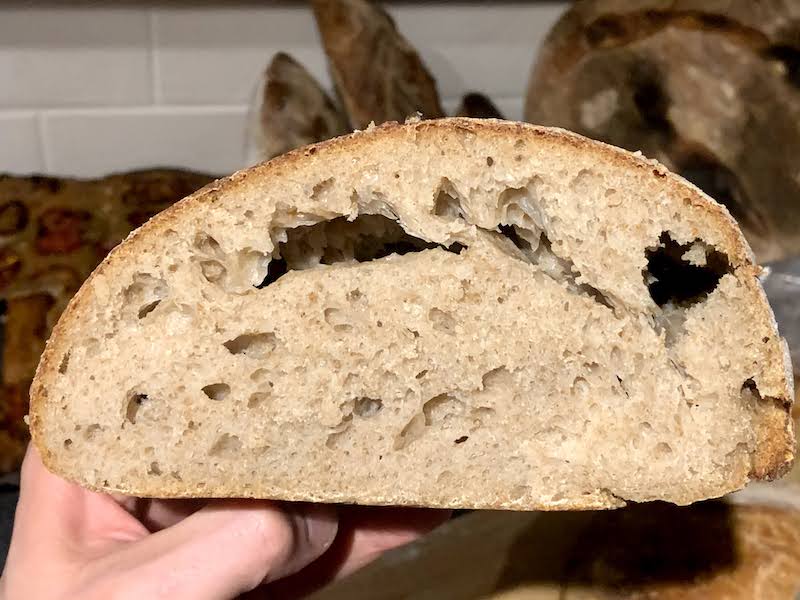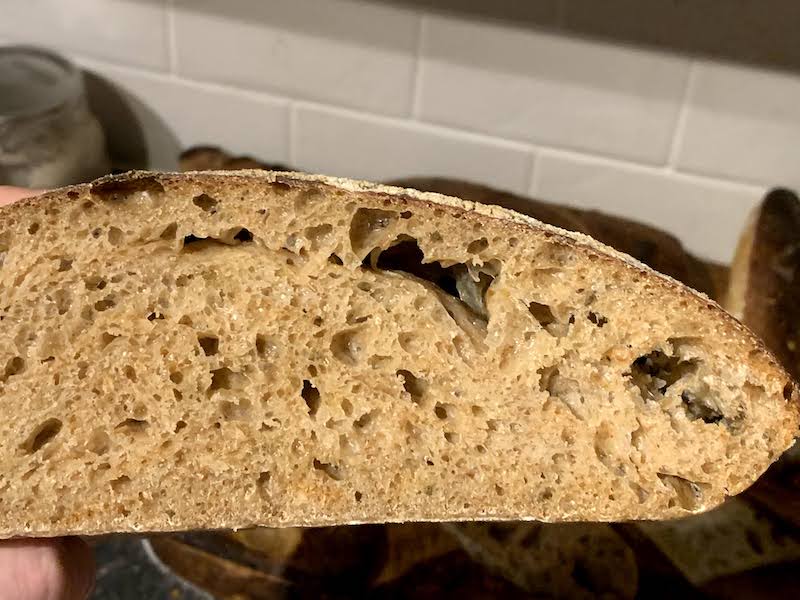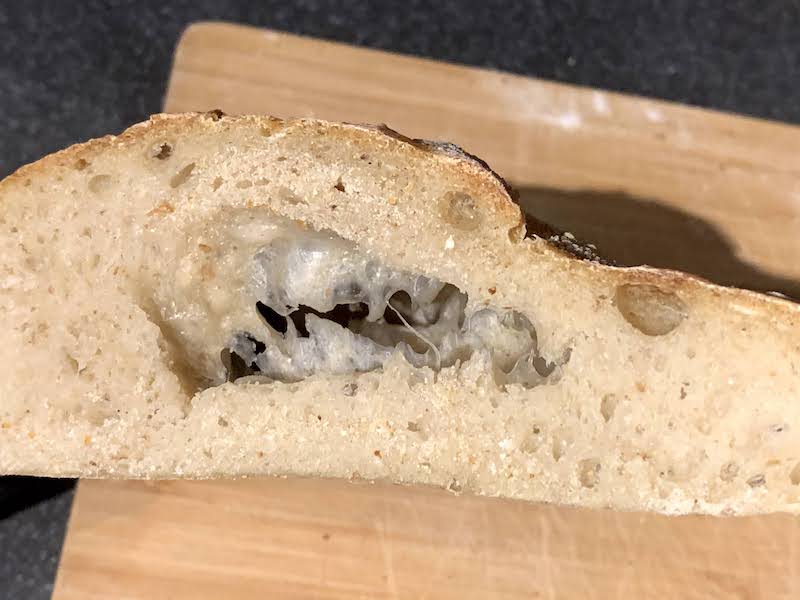I hope I can find a master baker here, who can help me / verify that the most likely source of my issue is the starter / point me in a different direction re/ this problem :)
So, new to sourdough baking, I churned out quite a few loafs, but none of them were really successful.
Typical Experience:
What I often experience is what seems to me both signs of underproofing and overproofing at the same time!
E.g. the loaf comes out with the large air tunnels that are supposed to be typical for underproofing, together with the characteristically dense bottom of the crumb. However at the same time there are signs of overproofing, especially re/ the gluten structure.
What I mean is a) by the time the bulk fermentation is over, the dough is very, very soggy and very, very sticky, like octopus tentacles (as I read it elsewhere) clutching everything. This is with having done either Rubaud method+3 stretch&fold, or 6 stretch&fold for high hydration doughs and just kneading until the window pane test comes out fine (between 8-12min) and rest during the bulk fermentation earlier, so the gluten structure development had been done.
The dough literally sticks to the wetted work surface and don't hold any shape during pre-shaping and shaping. It literally doesn't let itself be taut, turned, lifted, etc... If it lands by some miracle in the banneton, after retarding and fridge proofing, there is no rise in the oven at all (overproofing sign).
The loaf sticks extremely to the banneton, although ample rice flour was applied. When turning the banneton over on top of the baking sheet, the dough sticks to the basket like long strands of chewing gum. It also plops onto the surface, spreading out like a pancake, rather than keeping it's taut shape. The next issue is that the loaf comes out of the dutch oven without any features at all. The ripples from the banneton don't contribute to the surface structure of the loaf, neither does scoring! All surface features again are being washed out in the oven. All these to me would be more typical "overproofing" signs. Overproofing signs typically all relate to losing the gluten structure though, so my hunch is that the gluten structure is lost for different reasons. Hence: acidity? Too many lactobacilli?
Edit: starter
starter is about 4 weeks old, is fed with a 50/50 mix of organic whole wheat and a kind of white flour (most often white bread flour). Feeding first happened once every 24 hours and since a few days feeding is done when the starter is in the beginning of shrinking.
i keep it at 100% hydration and feed it in a 1:3:3 ratio since two weeks now. It rises and falls predictably. In the second week, it still wasn’t going strongly, I then added half a teaspoon of organic probiotic yogurt into the mix for a few days in a row.
Recipes
I used a bunch of different recipes. Generally there typically is a 4 hour bulk fermentation duration time, pre-shaping, shaping, bench rest for low-percentage starter amounts (15%, 17%), fridge proofing, baking.
Example A:
Autolyse 16:45
Mix at 17:45 with 19% mature levain, 70% all purpose, 12% white bread flour, 18% whole wheat flour, 2% salt, 66% warm water and final dough temperature 28C with a room temp at 21C
4.5h bulk fermentation (dough cooled down to 23.6C)
22:30 pre shape, bench rest, 23:05 shape and fridge.
Bake next morning:
Example B:
Followed this recipe precisely, including timing and temperature and flour type: https://www.theperfectloaf.com/a-return-to-basics/
The crumb isn't great, no oven spring at all, it almost fell apart when it came to shaping

Example C:
Kitchen temp: 23C
Autolyse 06:45 of 400ml water (80%) and 500g all purpose
Mix in 07:55 80g levain (16%) 12g starter whole wheat, 34g whole wheat, 34g water. 2% salt. Rhudart method 4min
Stretch and folds:
08:15 8 times 08:45 stretch and fold 8 times
09:15 stretch and fold 4 times
09:44 stretch and fold 4 times added salt (forgot earlier)
10:15 stretch and fold 4 times
11:15 lamination
12:00 pre shape and shape
12:30 fridge
comes out like a freaking pan cake:
Example D (quarter size):
This is probably as good as it can get with my starter, I controlled everything I could. And the result is "not bad", but still it was a bitch to work with, and octopus tentacle sticky flat pancake, at only a hydration level of 65%!
Autolyse 06:30 100% BF (bread flour 14% protein) 63% water at 29.5C dough temperature (warm water 32.5C)
07:30 mix in mature levain (100% hydration, equal mix of whole wheat and bread flour) and 2% salt
kneading for 13 minutes until it easily passes window pane test
mixing glas bowl immersed in sous-vide controlled water bath with dough temperature kept at constant 26.5C
Pre-shaping and shaping at 11:45 and 12:15 and final proof in the fridge. shaping is a horrible sticky experience!
Comes out with an alright crumb, but overall again no oven spring after baking in the dutch oven.

All bakes were in an oven at 260C and reduced to 245C after 20 minutes.
Is it the starter?
The question after a good dozen of loafs, to no success (unless I use commercial yeast instead of sourdough starter), is it the starter? What can I do to rescue the starter? Should I start with a new starter?
Please help, Obi-Wan Kenobi, you are our only hope :)
Florian, I’ve never had that particular problem. It is called a “flying roof”.
Click THIS LINK for a host of information.
Danny
Danny, thank you,for having a look. Actually, I am aware of the flying roof, do you suggest it is an actual over proofing (time+temperature ) issue? For one, it definitely wouldn’t apply to the last example, which was incredible precise, doesn’t have a flying roof, but still lacks gluten strength, despite using bread flour, kneading and perfect proofing time and temperature. To my knowledge flying roof relates to over proofing, do you agree? What would you say how sober proofing could relate to any of the attempts? I just don’t see how I could have technically ran into overproofing, given time and temperature.
Hi Florian, I have to agree with Dan, what you’re describing especially with respect to the stickiness of the dough and the fact that it has lost structure and doesn’t hold its shape well at the end of bulk fermentation are classic signs of over proofing. The flying roof is an extreme example of over proofed bread, but your examples are milder examples to me. The fact that your loaves bake up somewhat flat is one of the signs. Have a look at the crumb between the larger holes first. Underproofed crumb is super super tight and gummy, your crumb isn’t that dense or tight. There are signs of proteolytic action from over fermentation, loss of cell structure in the crumb, collapsing aleovi. You can see this at the tops of your breads, the coalescing holes from gluten weakening from proteolytic action so what would have been multiple holes becomes larger and larger holes as the gluten fails to hold the gases in.
Benny
Thank you, Benny.
It seems strange to me, as in some iterations I tried shorter bulk fermentation times too, didn’t come out right. But thank you, I will iterate on the last quarter size one and reduce times and see what happens!
Hi, Florian!
I’m not seeing much info about your starter. How old is it? What, and how often, do you feed it? Do you keep it on the counter or in the refrigerator? How much does it rise, and how quickly? How does it smell?
As I’m sure you probably know (you sound like you’ve done quite an extensive amount of research), proofing times can be affected by a number of factors, such as ambient temperature and type of flour used. Proofing times are also greatly affected by the strength of the starter. Most usually, this equates to newer bakers who underproof because they have not yet reached the point where their starters are active enough. But could it be possible that your starter is somehow overactive?
Thank you, I now added a section on the starter, I forgot. Most recently I feed 1:3:3 at 100% hydration about twice a day, with half organic whole wheat and half bread flour. Usually rises at 22C within hours and doubles in size. I don’t have a recent log file how long it took :/ Lives on the kitchen counter between 18 and 24 degrees Celsius.
Please don’t assume that I know a lot, rather it’s a bit of a current obsession to get it right, I went down a rabbit hole so to say.
I will try to adjust proofing times down a bit.
I don’t recall you mentioning what % rise you are stopping bulk fermentation at and shaping your dough and then putting it into the fridge for cold retard.
Thank you for your help! I have the dough in a mixing bowl, so the % rise is hard to gauge for me. It looks somewhat larger than the initial dough, maybe 10 to 20% more on top of the dough. I can see fermentation bubbles forming though through the side of the glass mixing bowl and on top of the surface.
I’ve been using, as many others have, an aliquot jar. This is a way to accurately measure rise. I too had the same problem as you being unable to measure rise because of my bulking bowl/dish. After your first stretch and fold, pull off about 30g of dough, shape it into a ball and place it into a small narrow vessel. I use a specimen container, others use a spice jar. Try to press it evenly into the bottom of the jar with as few air pockets as possible. You can then mark its level. Keep it loosely covered and keep it with your bulk fermenting dough so the temperature and conditions are the same throughout bulk. You can then gauge rise very accurately. I’ve started to use this recently and have been better able to experiment and figure out more optimal fermentation of my breads.
Most bakers here end bulk fermentation at between 30-50% rise.
Thank you, I was already thinking of getting something like this: one litre measurement jug
Because I could more easily put it into the sous-vide water bath and control the fermentation temperature that way.
Wouldn't the dough deflate too much when prying it out of such a narrow topped vessel?
Thanks
Yes it might, that is why I suggested just taking a small 30 g portion of the dough and placing it in a small narrow container and using that to gauge the rise. That way you can continue using your current vessel to bulk ferment the main dough. The dough in the aliquot jar can later be added to the main dough at the time of pre-shape if you like.
I see, I misunderstood this as two different options (large jar, vs. small control dough jar) not as a single solution! Thanks, will try that
Hi all!
Thanks again for the help on this one. I do feel my initial suspicion was correct that it was something with the starter.
I compared:
1) "Healing" the original starter by further diluting it with several feedings with a 1:10:10 and 1:7:7 ratio, then a few 1:5:5 ones.
2) A splinter starter preserved at the "problematic state" I created a splinter starter that I kept in the fridge and fed with a 1:3:3 ration once a week, during two weeks, and then for three days regular 1:3:3 feedings at room temp before the bake
3) A completely new starter I started as a control. I didn't take any pictures. The loaf was fine, evenly distributed air pockets, but less oven spring, more flat.
These are the results, note that the recipe was the same for both loafs, the difference was the starter that has been used:
"healed" starter: - it kept it's shape during shaping and pre-shaping. The dough was easier to handle and to form into a round shape. The crumb has an even distribution of air pockets, nothing to shout home about, but solid. This is at 18% inoculation, 65% hydration, 77% bread flour and 23 whole wheat flour, no autolyse time, a few minutes of kneading, and two sets of stretch and folds, a kitchen temp of 23C/73.5F and 4.5 hours of bulk fermentation. This is a very small loaf as well, I used a cereal bowl as a proofing basket.
In comparison the loaf with what I assume is an "acidic" starter: Same issues as described in my initial post: very sticky to handle, after fermentation the dough almost attaches to your skin akin to tentacles. Very little gluten strength after bulk fermentation, shaping and preshaping is almost pointless, as the dough doesn't hold shape. Very hard too pick up from the surface and flip it into the proofing basket. The starter also smelled more acidic, something that I didn't notice earlier, as I haven't had anything to compare it with, but side by side the "healed" starter smelled more of ripe fruit and yeast fermentation, while the "acidic" starter had slightly more pungent notes. Nothing you would notice without the comparison, it was a subtle difference, but it was noticeable.
You can see the same "flying roof" as in the initial post, the density of the crumb at the very bottom is higher than in the middle of the crumb. Note again that this loaf is an exact copy of the first one in terms of proofing time and ingredients ratios and temperature. They were sitting side by side on the counter and in the fridge for proofing. I used the same shaping technique for both.
And the complete loaf, we see also it didn't hold it's shape as well, and there is less oven spring:
I am posting this, because it seems there is something to the "acidic" starter hypothesis, and there isn't all that much information out there on this issue.
I almost want to re-do some of the loaf recipes from the initial post now, and see how it turns out.
Thoughts?
It's real, it happens, it causes problems - a big one happens to be misdiagnosis (over or under). I've come across many posts with the issue of dough turning into sticky globs. So much so that the "acidic" starter theory and fix have moved to the top of my most likely causes. Actually, it's not theory. Gluten formation is inhibited if ph goes to low. And the easiest way to get an acidic starter is to underfeed over time - the more under fed the quicker it goes out of balance (new to sd, new to starters, everyone says 111 ratio daily = underfed starter in a couple weeks, highly acidic right after that). Info on this is in here, I know cuz I put it here, but finding it may not be all that easy in a format such as this.
Fortunately it's easy to spot, and easy to fix, and easy problems are the ones to have. Enjoy!